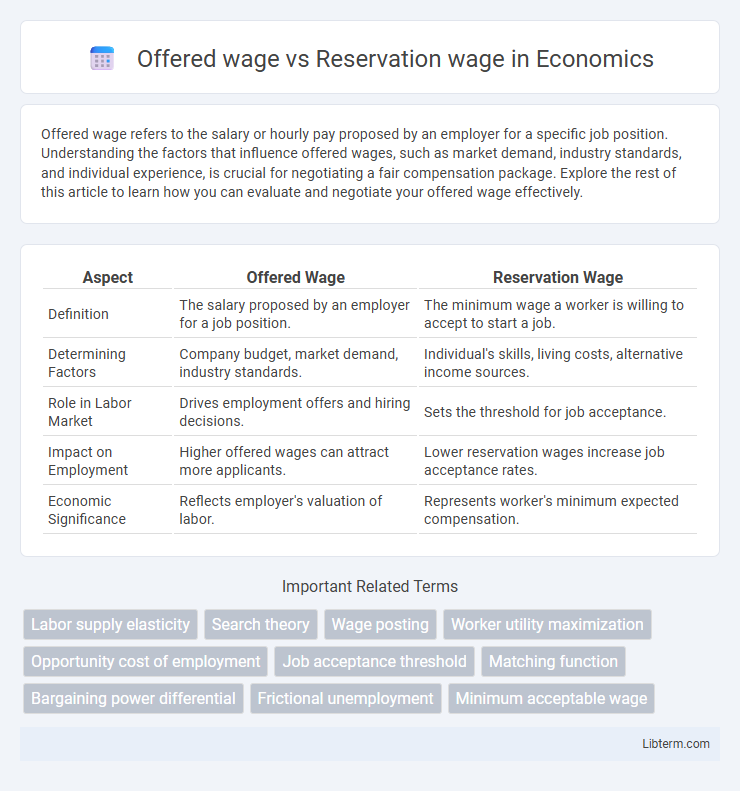Offered wage refers to the salary or hourly pay proposed by an employer for a specific job position. Understanding the factors that influence offered wages, such as market demand, industry standards, and individual experience, is crucial for negotiating a fair compensation package. Explore the rest of this article to learn how you can evaluate and negotiate your offered wage effectively.
Table of Comparison
| Aspect | Offered Wage | Reservation Wage |
|---|---|---|
| Definition | The salary proposed by an employer for a job position. | The minimum wage a worker is willing to accept to start a job. |
| Determining Factors | Company budget, market demand, industry standards. | Individual's skills, living costs, alternative income sources. |
| Role in Labor Market | Drives employment offers and hiring decisions. | Sets the threshold for job acceptance. |
| Impact on Employment | Higher offered wages can attract more applicants. | Lower reservation wages increase job acceptance rates. |
| Economic Significance | Reflects employer's valuation of labor. | Represents worker's minimum expected compensation. |
Understanding Offered Wage and Reservation Wage
Offered wage represents the compensation amount an employer proposes to a job candidate based on market rates, job requirements, and the candidate's qualifications. Reservation wage is the minimum salary a job seeker is willing to accept, reflecting their personal value, alternative opportunities, and living costs. Comparing offered wage to reservation wage helps determine the likelihood of job acceptance and influences labor market dynamics.
Key Differences Between Offered Wage and Reservation Wage
Offered wage refers to the actual salary or compensation proposed by an employer to a job candidate, while reservation wage is the minimum acceptable salary that a job seeker is willing to accept. Key differences between offered wage and reservation wage include that the offered wage is employer-driven and influenced by market conditions, company budget, and job role, whereas the reservation wage is individual-driven, reflecting personal financial needs, skills, and alternative employment opportunities. Understanding the gap between these wages is crucial for successful job negotiations and labor market efficiency.
Factors Influencing Reservation Wage
Reservation wage is influenced by factors such as individual skill level, labor market conditions, and personal financial needs. Higher education and specialized expertise typically raise the reservation wage, reflecting greater opportunity costs. Economic stability, unemployment benefits, and social safety nets also shape the minimum acceptable wage a worker demands before accepting job offers.
Determinants of Offered Wage in the Labor Market
Offered wage in the labor market is primarily determined by factors such as the worker's skill level, industry demand, and employer's budget constraints, which influence the monetary compensation proposed to potential employees. Market conditions, including unemployment rates and competition among firms, also shape the wage offer by affecting the supply and demand balance for specific job roles. Geographic location and firm size further impact offered wages, as companies in urban areas or large corporations tend to offer higher wages compared to rural firms and smaller businesses.
The Role of Bargaining Power in Wage Negotiation
The offered wage reflects the employer's initial salary proposal, while the reservation wage represents the minimum acceptable pay for the employee, determined by their alternative opportunities and financial needs. Bargaining power significantly influences the final wage outcome, with stronger negotiating leverage enabling employees to secure offers closer to or above their reservation wage. Employers with greater bargaining strength can suppress wages by capitalizing on labor market conditions and employee urgency.
Economic Theories Explaining Wage Gaps
Offered wage and reservation wage are key concepts in labor market economics, where the offered wage is the salary proposed by employers and the reservation wage is the minimum acceptable pay set by workers. Economic theories like the job search model explain wage gaps by highlighting the mismatch between these wages due to information asymmetries and bargaining power differences. Human capital theory also emphasizes that variations in skills and productivity lead to disparities between offered and reservation wages, contributing to persistent wage gaps.
Impact of Labor Market Conditions on Wage Expectations
Offered wage represents the actual salary proposed by employers, while the reservation wage is the minimum acceptable pay a worker is willing to accept. Labor market conditions, such as unemployment rates and job availability, directly influence these wage expectations; tight labor markets generally increase reservation wages and lead to higher offered wages. In contrast, high unemployment and abundant job seekers tend to suppress offered wages and lower reservation wage thresholds.
Employer Strategies to Bridge Wage Disparities
Employers implement strategic wage-setting practices to align offered wages with workers' reservation wages, minimizing turnover and attracting qualified candidates. Techniques such as wage negotiation, performance bonuses, and tailored compensation packages address individual reservation wage thresholds while maintaining budget constraints. Leveraging labor market analytics enables firms to optimize wage offers, balancing competitiveness with cost-efficiency to bridge wage disparities effectively.
Consequences of Mismatch Between Offered and Reservation Wages
A mismatch between offered wages and reservation wages often leads to prolonged unemployment or job search duration, as job seekers reject offers below their minimum acceptable pay. Employers may face increased recruitment costs and delays in filling vacancies, which can reduce overall productivity and economic efficiency. Persistent wage mismatches can also contribute to labor market segmentation, where certain groups remain marginalized due to incompatible wage expectations.
Policy Implications for Equitable Wage Setting
Offered wage and reservation wage disparities highlight the need for policy measures ensuring minimum wage standards reflect living costs and worker productivity, promoting equitable labor markets. Implementing targeted wage subsidies or minimum wage adjustments can bridge the gap, preventing labor market exclusion of low-skilled workers. Equitable wage setting policies encourage fair compensation, reduce income inequality, and support inclusive economic growth.
Offered wage Infographic

 libterm.com
libterm.com